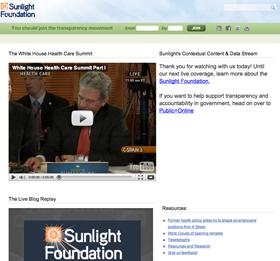$10,000 Grand Prize Winner
Sunlight Live
sunlightfoundation.com/live/archive/hcrsummit/
Sunlight Foundation, Washington, D.C.
From the judges: “They showed how to add journalistic punch to a carefully orchestrated government event, adding context and insight to the proceedings. And they don’t stop at merely shedding light on the behind-the-scenes proceedings of government – they go a step beyond to make it fun and engaging, creating a social experience around the event.”
An innovative blending of data, streaming video, liveblogging and social networking, Sunlight Live attracted nearly 43,000 users in its first use at the bipartisan health care summit in February 2010. The judges not only honored the project for its individual merits, but also because it epitomizes the Sunlight Foundation’s entire body of work.
The experiment, detailed in this blog post and this demo video, was designed to prove that live coverage can come from anywhere “with relatively minimal development, production and promotion”. As people watched the live streaming video, the team added additional reporting and document links on the opposite side of the screen, hosted a live blog, and displayed an evolving log of Tweets about the event – all in one place. Plans are to continue to experiment with this model.
$1,000 Special Distinction Awards
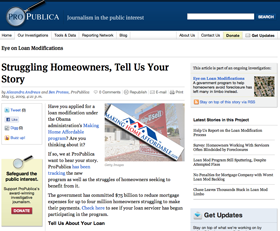 ProPublica Distributed Reporting
ProPublica Distributed Reporting
www.propublica.org/special/reportingnetwork-signup
ProPublica, Washington, DC
From the judges: “This is a major step forward with how we understand crowdsourcing.”
This investigative news site is systematizing the process of crowdsourcing, conducting experiments, polishing their process, and tasking citizens with serious assignments. Its more than 5,000 Reporting Network members have conducted spot checks on federal stimulus spending, unraveled loan modification stories, and tracked the oversight of state nursing board, among other efforts. ProPublica was also recognized with a Notable Entry for applications the nonprofit newsroom has developed.
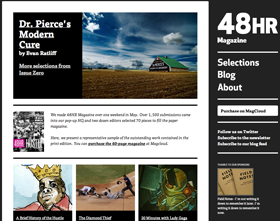 Longshot Magazine (Formerly 48 HR Magazine)
Longshot Magazine (Formerly 48 HR Magazine)
48hrmag.com/
Longshot Magazine (Formerly 48 Hour Magazine), San Francisco, CA
From the judges: “As important as the product was the work flow that they created.” In an era where most magazines go through a lavish multi-month production cycle, the 48 HR team made a spectacular 60-page magazine and online site in a weekend in May 2010 with little more than Twitter, coffee, grit and more than 1,500 submissions collected in just over a day. Although the print publication is no longer available for purchase, the execution demonstrated the potential of citizen-generated news at high speed.
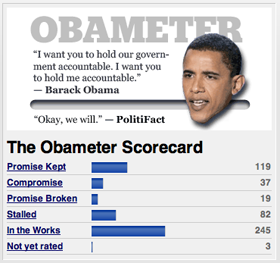 The Obameter
The Obameter
www.politifact.com/truth-o-meter/promises/
PolitiFact, St. Petersburg Times, St. Petersburg, FL
From the judges: “They made a game out of substance in a good way. It’s tracking a story that is unfolding into the future, which is not something we do very often.”
St. Petersburg (Fla.) Times’ PolitiFact pioneered a new form of accountability journalism by rating the progress of 500 of President Barack Obama’s campaign promises. Citizens and journalists can easily sort and search the progress reports in a distinctive database. Readers are invited to suggest updates and ratings. The paper continues to innovate, having received a Knight-Batten award
and a Pulitzer Prize in 2009 for PolitiFact.
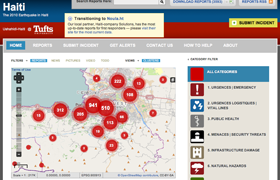 Ushahidi Haiti
Ushahidi Haiti
haiti.ushahidi.com/
Ushahidi, Medford, Mass.
From the judges: “They have set the bar for future mapping mashups.”
Less than two hours after Haiti’s devastating earthquake in January 2010, Ushahidi marshaled Skype, Twitter, Facebook, radio and short codes to crowdsource real-time needs. With 1,000 online volunteers translating text messages from Creole, and other volunteers mapping crisis spots, the effort had an unprecedented impact on disaster relief efforts. Ushahidi was also a 2008 Knight-Batten Special Distinction award winner.
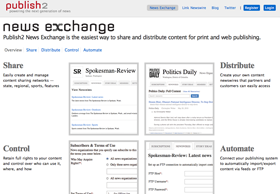 Publish2 News Exchange
Publish2 News Exchange
www.publish2.com/about/news-exchange/
Publish2, Lansdowne, Va.
From the judges: “This is an ambitious concept that could be genuinely disruptive of existing distribution networks.”
Introduced in May 2010, this platform allows news organizations to interact directly with one another to create custom newswires and set terms for collaborating and sharing content. It moves the newswire from a traditional “hub-and-spoke” model where everything is distributed through a central place to a genuine network of information sharing.
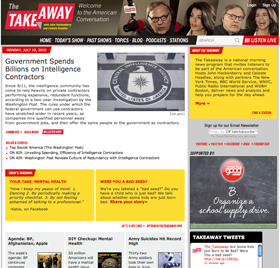 Sourcing Through Texting
Sourcing Through Texting
www.thetakeaway.org/
The Takeaway, WNYC and Public Radio International, New York, N.Y. Public Insight Network and WDET Detroit
From the judges: “The experiment opened doors for engaging non-listeners in ways they liked.”
A team from The Takeaway radio show joined journalists from WDET Detroit in a successful experiment that prompted residents to text tips about particular stories from Mexicantown in Southwest Detroit. Residents texted information about trucks illegally barreling down their side streets, and in another experiment, they sent keywords describing their neighborhoods. The result: non-listeners became engaged and more informed. The experiment has continued in Miami’s Little Haiti.
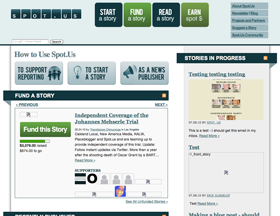 Community Centered Advertising
Community Centered Advertising
spot.us/
Spot.US, San Francisco, Calif.
Created by crowd-funding pioneer Spot.US, Community Centered Advertising embraces innovation in the advertising arena. The process allows users to engage directly with advertisers by answering surveys or quizzes, and then directing real advertising dollars to the story pitch of their choice. Community-Centered Advertising gives the community control over how an advertising budget is spent.
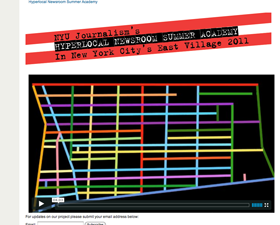 Collaborative Journalism
Collaborative Journalism
NYTimes.com/Chicago
The New York Times, New York, N.Y.
The New York Times is partnering with other outlets, including the Chicago News Co-op, The Bay Citizen, and CUNY and NYU to cover neighborhoods in New York. They are attempting to “equip residents to cover everyday life with journalistic standards.” A key innovation has been a change in expectations, allowing local editors, not Times editors, to control the “publish” button on sections of NYTimes.com.
Also see:
- www.Chicagonewscoop.org
www.NYTimes.com/BayArea
www.Baycitizen.org
NYTimes.com/fortgreene
journalism.nyu.edu/lev/
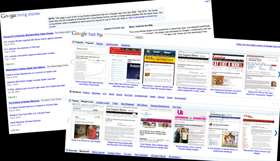 Google: Living Stories and Fast Flip
Google: Living Stories and Fast Flip
livingstories.googlelabs.com/
Google, Mountain View, Calif.
Living Stories was an experiment developed by Google in which The New York Times and The Washington Post tried a different approach to displaying news online. With coverage unified on a single, dynamic page, information was organized by story developments so you can easily find the new material. Living Stories automatically tracks user interactions with the story, helping readers get the latest updates to the stories they follow and sift through the coverage in novel ways. The Living Story platform is open source, so any interested publisher can continue to use it.
With Google Fast Flip (fastflip.googlelabs.com/), users can “flip” through pages online as quickly as flipping through a magazine. It also enables people to follow friends and topics, discover new content, and create their own custom magazines around searches.
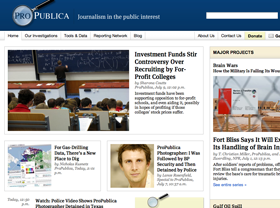 ProPublica News Apps
ProPublica News Apps
bailout.propublica.org/
ProPublica, New York, N.Y.
The investigative non-profit continues to pave the way in inventive collaborative work, developing a number of news applications to make data accessible to many. The Recovery Tracker, for instance, enabled readers to see the stimulus projects under way in their county. TableSetter lets newsrooms use Google spreadsheets as a “Data CMS,” giving reporters the ability to keep an important set of tabular information that’s live on the web up-to-date without having to wait for developer assistance.
See also:
- projects.propublica.org/recovery
projects.propublica.org/unemployment
projects.propublica.org/stimulus-speed-chart
projects.propublica.org/lpacs
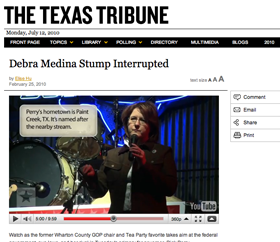 Stump Interrupted
Stump Interrupted
www.texastribune.org/search/?q=Stump%20Interrupted
Texas Tribune, Austin, Texas
Stump Interrupted is a twist on the traditional stump speech. Using pop-up bubbles and illustrations over video, Stump Interrupted adds context and value to canned speeches delivered by politicians or candidates. In the first six months of the project, the videos were viewed nearly 10,000 times.
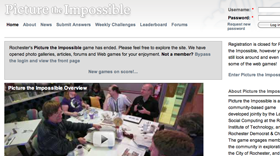 Picture the Impossible
Picture the Impossible
www.picturetheimpossible.com
Rochester Democrat & Chronicle, Rochester, N.Y.
This community-based game had citizens of Rochester exploring the city, scoring points through Web- and newspaper-based games, such as video quizzes and interactive maps and crosswords and clues hidden in printed pages. Users also scored points by meeting face-to-face at live events, including scavenger hunts and photo assignments. In the process, the 2,500 players raised thousands of dollars for charity.
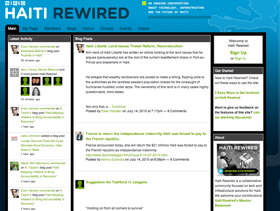 Haiti Rewired
Haiti Rewired
haitirewired.wired.com/
Wired Magazine, San Francisco, Calif.
Haiti Rewired is a collaborative blog, based on a Ning platform, aimed at reporting on and recommending grassroots technology solutions to reconstruct Haiti. The project has drafted an earthquake resistant construction manual tailored for Haiti, built three Web-based frameworks for creating volunteer and NGO databases for Haiti, and brought a wireless hotspot into Port-au-Prince to provide connectivity for a blogging community.
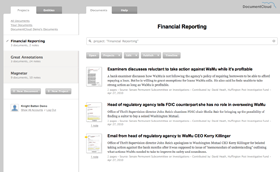 DocumentCloud
DocumentCloud
www.documentcloud.org
DocumentCloud, New York, N.Y.
DocumentCloud is designed to improve journalism by making documents easier to search, analyze, find and publish to the web. With reporting relying heavily on primary source documents, there are few tools available to help journalists find that needle in a haystack, and then share those revelations with the public. DocumentCloud incorporates The New York Times’ Document Viewer, which was part of the Times’ winning entry in the 2009 Knight-Batten competition.
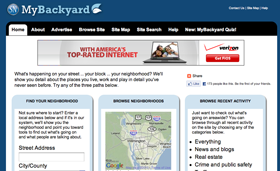 MyBackyard Coastal Carolina
MyBackyard Coastal Carolina
mybackyard.starnewsonline.com
Star-News,Wilmington, N.C.
MyBackyard is a hybrid hyperlocal site that brings the power of a data aggregator such as EveryBlock to a small geographic area: New Hanover County, N.C. MyBackyard combines news and blog posts with data such as crimes, arrests, traffic accidents, real estate transactions and events listings.
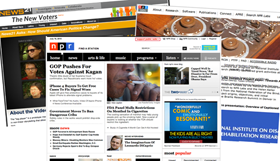 NPR: NPR.org, Captioned Radio, and “Drug Can Stop Strokes, But Most Patients Don’t Get It”
NPR: NPR.org, Captioned Radio, and “Drug Can Stop Strokes, But Most Patients Don’t Get It”
www.npr.org
NPR, Washington, D.C.
NPR’s three Notable Entries all demonstrate the public broadcaster’s attempts to accelerate its mission “…to create a more informed public – one challenged and invigorated by a deeper understanding and appreciation of events, ideas and cultures…” On NPR.org, correspondents have learned to use smart phones, Skype, cloud-based applications and Twitter to enhance their digital reporting. Captioned Radio continues to research the use of new technology to reach a hearing-impaired audience. And the multimedia story
on a clot-busting drug used for stroke victims included a Zip Code-driven database of hospitals providing the treatment.
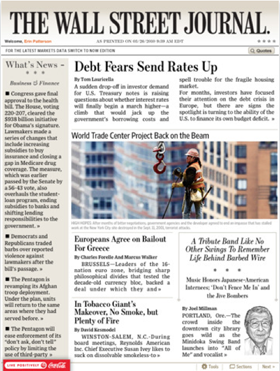 The Wall Street Journal for iPad
The Wall Street Journal for iPad
online.wsj.com/public/page/ipad.html
The Wall Street Journal, New York, N.Y.
One of the first apps designed specifically for the iPad delivers the Journal’s news coverage quickly and in its entirety, providing each complete daily issue in a seven-day archive available to readers whether they are connected or offline. An updating “Now” edition offers people the latest breaking news and the news judgment of Journal editors throughout the day.
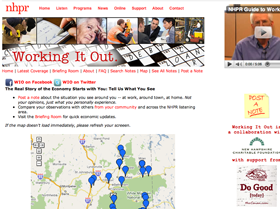 Working It Out
Working It Out
www.nhpr.org/wio
New Hampshire Public Radio, Concord, N.H.
“Working it Out” is a section of NHPR’s website for people to share descriptions and experiences about the impact of the recession by posting “notes” on the WIO site. The crowdsourcing application is organized by topic or community, displayed on a map, and is publically available.
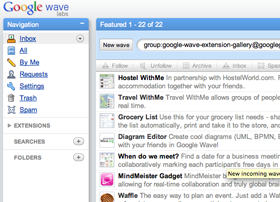 Lakewood Shooting
Lakewood Shooting
seattletimes.nwsource.com/ABPub/2009/12/01/2010396205.pdf
The Seattle Times, Seattle, Wash.
The Seattle Times newsroom used Google Wave to provide real-time information after a man gunned down four police officers in a diner. Twitter was used simultaneously, but Wave, which had just been released, had an even greater response. Its use illustrated the viability of real-time newsgathering and presentation platforms other than Twitter.
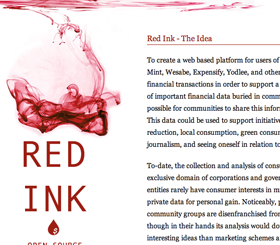 Red Ink
Red Ink
MIT Media Lab, Center for Future Civic Media, Cambridge, Mass.
Red Ink is experimental open source software created by the MIT Media Lab for analyzing consumer financial transactions. Its major goal is to empower communities to use their collective financial data as a resource for self-knowledge and advocacy.
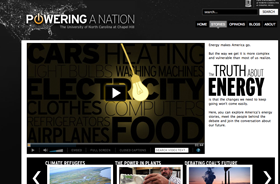 Powering a Nation
Powering a Nation
School of Journalism and Mass Communication, University of North Carolina, Chapel Hill, N.C.
This visually appealing site investigates the political, economic, and scientific tensions behind U.S. energy use with multimedia reporting. It also contributes to the ongoing energy debate through a blog, social media accounts, and featured editorials. The project is a member of the News21 collaboration, which is part of the Carnegie-Knight Initiative on the Future of Journalism Education.
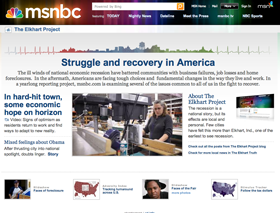 Elkhart Project
Elkhart Project
elkhart.msnbc.com
MSNBC.com, Redmond, Wash.
Using the town of Elkhart, Ind., as a prism with which to explore the financial crisis, MSNBC.com offered users slideshows, multimedia and blog posts to tell the story. The microsite included custom applications like the Stimulus Tracker and the Adversity Index, created in partnership with Moody’s.
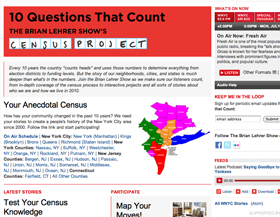 10 Questions that Count: The Brian Lehrer Show’s Census Project
10 Questions that Count: The Brian Lehrer Show’s Census Project
beta.wnyc.org/shows/bl/census/
WNYC, New York, N.Y.
The Brian Lehrer Show covered the 2010 U.S. Census by gathering the stories of change in its communities over the past 10 years. With radio as the backbone, the project incorporated live events, interactive web elements, original videos and quizzes into coverage. The narrative exists in both traditional and new media efforts.
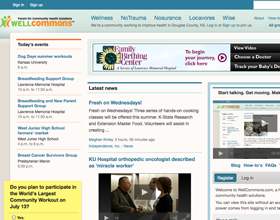 WellCommons: A New Approach to Local Health Reporting
WellCommons: A New Approach to Local Health Reporting
wellcommons.com/
Lawrence Journal-World, Lawrence, Kan.
WellCommons provides the community with new social media tools to participate and collaborate with reporters in an attempt to aid the health problems in Douglas County, KS. The site structure helps people assess the reliability of information based on who posted the information, using their real names, and where it’s posted.
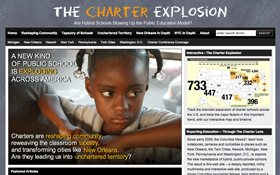 Charter Explosion Interactive Map
Charter Explosion Interactive Map
columbia.news21.com/2009/
Graduate School of Journalism, Columbia University, New York, N.Y.
The Charter Explosion Interactive Map uses in-depth reporting, innovative interactivity and rich multimedia to closely examine the controversial charter school education movement. The site explores the factors that have prompted thousands of these hybrid public-private institutions to emerge since the 1990’s, as well as the future implications for education and for community diversity. The project is a part of News21, a component of the Carnegie-Knight Initiative on the Future of Journalism Education.
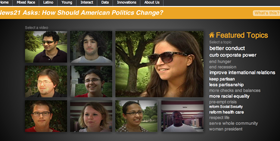 Video Tag Player
Video Tag Player
news21.com/2010/04/marylands-video-tag-player-making-it-easy-to-use/
Philip Merrill College of Journalism, University of Maryland, College Park, Md.
The Video Tag Player allows users to navigate video clips by selecting keywords. Fellows at the University of Maryland’s Philip Merrill College of Journalism, a partner in the News21 collaborative, conceived the player as a way to present a large collection of video clips in a searchable system that lets viewers quickly find what interests them.
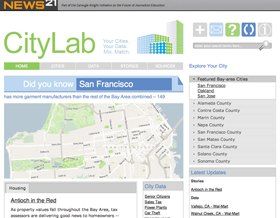 CityLab
CityLab
citylab.news21.com/
Graduate School of Journalism, UC Berkeley, Berkeley, Calif.
CityLab is a database that collects and displays demographic data on 65 cities throughout the San Francisco Bay Area. It is a working prototype for a nationwide city database that will allow reporters to compare important, but hard-to-find information about cities all over the country. CityLab is a project of News21, a part of the Carnegie-Knight Initiative on the Future of Journalism Education.
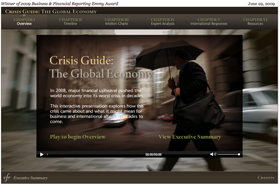 Crisis Guide: The Global Economy
Crisis Guide: The Global Economy
www.cfr.org/economyguide
Council on Foreign Relations, New York, N.Y.
The Crisis Guide, a Knight-Batten First Prize winner in 2007, this year explored the causes and consequences of the global economic crisis. The Guide takes reams of data and organizes it for better understanding. It was written with insights from leading thinkers on economics and international affairs. It offers a video overview, a three-part timeline, interactive Google Motion Charts, expert video analysis, a map of global responses, and a list of resources for further inquiry.
 American Visualizer
American Visualizer
www.americanvisualizer.com
Medill, Northwestern University, Chicago, Ill.
In its alpha version, American Visualizer allows users to tap into the wealth of American FactFinder data and customize it for their needs an in easy to use interface. The tool takes advantage of the Open Flash Chart open source visualization library and could prove beneficial in helping citizens harness Census data for the first time.
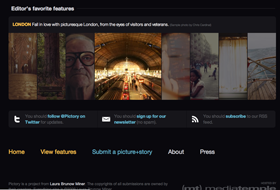 Pictory
Pictory
www.pictorymag.com/
Pictory, San Francisco, Calif.
Using vivid online photographs to tell a story, Pictory cultivates a community of shutterbugs and enthusiasts to post captioned photos in a storyline. Each photo is its own story but is related to the others in the stream. The site is also partnering with others, including The New York Times.
 Gulf Oil Leak Meter
Gulf Oil Leak Meter
www.pbs.org/newshour/rundown/horizon-oil-spill.html
PBS NewsHour, Arlington, Va.
As oil continued to gush into the Gulf of Mexico from a BP well on the seabed, the staff of PBS NewsHour created an interactive widget to demonstrate the impact. It allows users to choose which source they trusted most (BP or NOAA) and use a slider to calculate their own corresponding total leakage estimate in gallons, a term more easily understood than “barrels.” The meter, designed to look like an old gasoline pump, is updated in real-time.
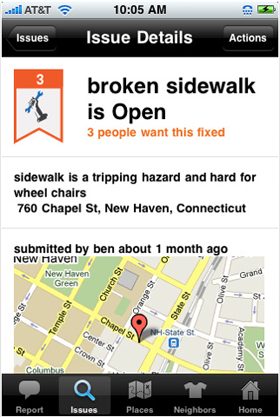 SeeClickFix News Web Widget
SeeClickFix News Web Widget
www.seeclickfix.com/citizens
New Haven, Conn.
SeeClickFix, a pioneer in crowd-sourcing municipal issue reporting, encourages users to take an active role in exposing neighborhood problems. The company’s widget has made it easier for other sites to allow users access to SeeClickFix. The tool also allows journalists to track community issues in their stories.
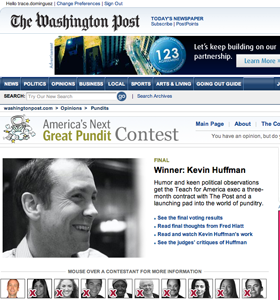 America’s Next Great Pundit
America’s Next Great Pundit
views.washingtonpost.com/pundits/
The Washington Post, Washington, D.C.
“America’s Next Great Pundit” was a reality-show-style competition for a spot on The Washington Post’s opinions roster. In addition to finding a new voice, they wanted to leverage web technology to give readers an unprecedented say in the selection process. The competition highlighted what it takes to be a modern-day, multi-platform pundit, and awarded a three-month writing contract to a Teach for America staffer.
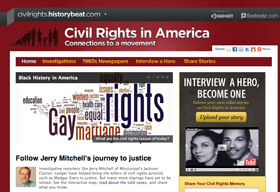 Civil Rights in America: Connections to a Movement
Civil Rights in America: Connections to a Movement
civilrights.historybeat.com
Gannett, McLean, Va.
As part of a large undertaking with a number of Gannett newspapers and websites across the country, “Civil Rights in America” includes a dynamic omnibus page featuring digitized newspaper clippings, blogs and video all updated continually. The local pages include nationwide content and items specific to individual markets. Using Gannett’s ContentOne approach the paper sites have branded content and use archival print and video footage from the 1950’s and 1960’s, along with breaking news.
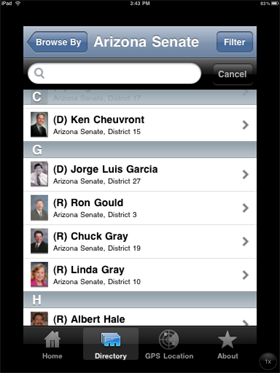 Arizona Political Directory App for Mobile
Arizona Political Directory App for Mobile
itunes.apple.com/us/app/arizona-political-directory/id369575859?ign-mpt=uo=2mt%3D8uo%3D2
New Media Innovation Lab, Arizona State University, Phoenix, Ariz.
Designed to serve as ArizonaGuardian.com’s pocket political directory of Arizona’s federal, state and local elected officials, this guide offers users photos and contact information. On GPS-equipped phones, this shows a list of elected officials based on the user’s current location. ArizonaGuardian.com routinely updates the app to reflect election outcomes and other changes.





